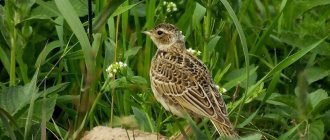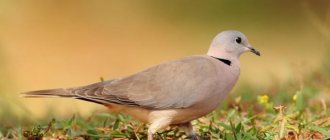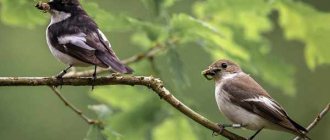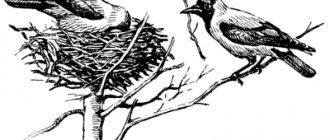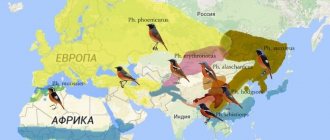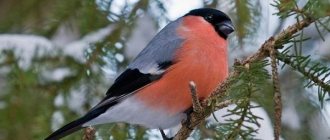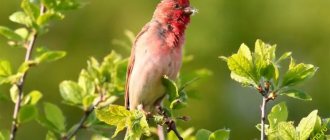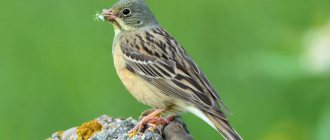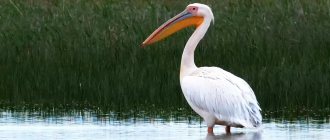| Latin name: | To be confirmed |
| English name: | To be confirmed |
| Kingdom: | Animals |
| Type: | Chordata |
| Class: | Birds |
| Squad: | Passeriformes |
| Family: | Larks |
| Genus: | To be confirmed |
| Body length: | 11-20 cm |
| Wing length: | 9.5—11.5 cm |
| Wingspan: | 35 cm |
| Weight: | 29—70 g |
Singing
— Advertising —
The song of larks is filled with many varied and exciting sounds. Moreover, each sound has a distinctive feature, which depends on the type of lark, age, experience, individual characteristics and habitat. Despite this, the singing is simple and melodic. Consists of whistled phrases that are pronounced one after another with short pauses. Each phrase sounds with a slight decrease in tone. Despite this, listening to the singing of larks is a pleasure for most. In addition, larks are able to imitate the sounds made by birds or animals.
Wintering
Larks are migratory birds, so they fly to the south of Europe in the winter. The reason for this behavior is that closer to November there is little food left in the fields. Therefore, larks gather in small flocks and fly south from the beginning of September. At the same time, they return in early March, regardless of whether the snow has melted or not.
By the arrival of larks, most people in the old days determined the onset of spring and the time when it was time to plow the land.
Reproduction and offspring
With the onset of spring, these birds return to their former nesting sites and the males are the first to arrive to improve their nests. These birds know how to make the nest practically blend into its surroundings. The eggs laid in the nest also have a camouflage color, since dark spots are scattered on their surface. After the pair has formed, the female begins to lay eggs.
On average, the female lays 5 eggs, and she does this 2 times per season. The female incubates the eggs for 2 weeks, after which completely blind and almost naked chicks are born. Over time, this fluff, which covers the body of the chicks, will turn into thick plumage.
About a month after birth, the chicks are in no way inferior to the adults and begin an independent life. Both parents feed the newly born offspring, bringing seeds of various cereal (small) plants to the nest. To improve the digestion process, parents give the chicks an additive in the form of small stones. As a rule, they form small lumps from grains of sand and give them to their young.
Habitats
— Advertising —
Larks live mainly in steppes, meadows, fields, wastelands, forest clearings, forest edges and even in the mountains. At the same time, they prefer an area with a lot of grass and moisture, so they sometimes settle in swamps. Larks are found throughout Europe and Asia, as well as North Africa, South Australia and New Zealand.
Larks keep in small flocks in small open areas that are well warmed by the sun's rays. However, they seek shelter from the rain and wind on the edges. As a rule, they do not prefer to sit on branches or wires, so they spend most of their time on the ground.
Larks make nests on the ground in small holes. In this case, construction is carried out exclusively by the female, who weaves it from leaves and grass stems, after which she puts fluff, horsehair and wool inside. The nest is built on the ground, securely camouflaged among the grass.
Nutrition
They prefer to eat exclusively plant foods, giving preference to plant seeds. Most often, the diet consists of seeds of pikulnik, sparrowgrass, bird grass, bird buckwheat, wild millet, oats and wheat. In addition, larks occasionally peck small pebbles and sand on rural paths. This is done to help digest the hard seeds. With the appearance of insects, larks begin to hunt for them. However, larks hunt only on the ground or catch insects crawling on tall grass. Among insects they prefer beetles, spiders, larvae, pupae and butterfly caterpillars. Thirst is quenched with the help of dew that settles on plants.
What do they eat?
The lark's diet includes a very varied diet, consisting of components of both plant and animal origin. It feeds on almost everything it can find on the surface of the earth.
Interesting moment! These birds, along with the food they find, swallow small pebbles to improve the digestion process.
Among the variety of grain crops, wheat and oats are considered his favorite foods. They are excellent hunters, as they hunt small insects, which bring great benefits to agricultural lands.
wood lark
The wood lark or spinning top is a small bird, similar in size to a sparrow. The upper body, wings and tail of the wood lark are colored brownish-brown. Her abdomen, along the edge of her tail and “eyebrows” are white. There are longitudinal brown streaks on the back and chest, but they are wider on the back. In addition, elongated feathers are found on the cheeks and small crest of the wood lark.
Often found on forest edges and in mountain steppes with sparse bushes. However, it inhabits only those places where there is a clearing or deforestation with good warming by the sun's rays. It lives in Europe, southwest Asia and northwest Africa.
The wood lark's song is simple and melodic, consisting of whistled phrases. Execution is fast. The wood lark is a lover of singing, so the song can be heard throughout the day, and sometimes can be heard on moonlit nights. The song is performed from trees, unlike other larks, and also during flight. At the same time, the wood lark's singing season occurs from March to July, and is sometimes heard in August.
Enemies
Since skylarks are small in size, they have a huge number of enemies. Nests are destroyed by various land mammals, and they eat not only eggs, but also chicks. Snakes also destroy masonry.
Adults are threatened by feathered predators. For falcons and hawks, larks are the mainstay of their diet. The main natural enemy for these birds is the hobby hobby; it deftly catches these small birds right in the air. The only way for the skylark to escape from it is to fall sharply to the ground.
Today, the population size is at a stable level; there is no need to talk about the extinction of these vocal birds.
If you find an error, please select a piece of text and press Ctrl+Enter.
Crested lark
The Crested Lark is similar to the Skylark, but is stockier and wider at the shoulders. A special feature of the lark is the ability to raise and lower its crest, in particular, this is done during the mating season. It is this large, pointed crest that gives the lark its special attractiveness. The beak is thin and brown on top, and light or yellowish below. The back is gray-brown with an ocher tint and with dark trunks. The crest on the head is black with narrow light edges, the throat along the edges consists of stripes of dark streaks. The belly is white, the body and sides of the crop are grayish. The legs are thin and pale brown in color.
The crested lark lives throughout almost all of Europe, Africa, Asia, Northern India, China and Korea. However, the distribution of the lark increases every year. In addition, it chooses a wide variety of open and semi-open biotopes for its place of residence; it has also managed to master agricultural landscapes, and in winter it moves closer to people and livestock yards.
They start singing early. At the same time, they can perform their song both in the air and while sitting on a tree. In winter, the song is short, similar to short ringing exclamations, but by March they are connected into a short song.
Description of color
Its back has gray, but more often brownish-yellow (clay-colored) plumage with white and dark spots. The breast of this bird has white or light gray feathers interspersed with rare brown spots. The wings are pockmarked. The tail itself is white along the edges and ends. The lark's head is also pockmarked, has darker stripes on top, closer to black or dark gray in color, and light brown on the sides. Above the dark eye is a bright white eyebrow. The male differs from the female in being larger in size and brighter in color. The protective coloring helps these birds skillfully camouflage themselves in the grass from predators.
Common lark
The common little lark is a small bird that looks like a sparrow. The color is predominantly grayish or ocher-sandy. There are dark narrow shafts on the shoulders, and on the back they are slightly wider. The head is reddish, the frenulum and eyebrows are painted in a pale salt shade, the ear feathers are brownish with dark edges. The underside of the abdomen is white with an ocher tint. The sides of the neck and crop have a dark spot. The beak is brown above and light below. The paws are long and pale brown.
The common little lark lives in southern Europe, northern and eastern Africa, as well as in Western and Central Asia. Sets up a nest in open steppe and desert spaces, rocky, gravelly, clay and sandy soils. In addition, it lives in salt licks with stunted vegetation, white-wormwood steppes, and rare and low-growing shrubs.
They start singing in the spring. At the same time, they sing both in the air and in the trees. The song is simple, abrupt and begins with a two-syllable exclamation with a clean second syllable.
Kinds
Field lark / Alauda arvensis
The skylark is a medium-sized bird, the size of a house sparrow: its body length is about 180 mm, its weight is about 40 g. The body is dense, the head is large with a relatively small cone-shaped beak. The bird looks a little heavy, but it runs quickly and deftly along the ground. The hind toe is armed with a very long, spur-like claw. The plumage of the dorsal side of the body is earthy-brown with yellowish-grayish-white dashes and black-brown spots. The head, throat, upper chest and sides of the body are rusty-brown with dark stripes; the rest of the chest and belly are yellowish-grayish white. There are two light, faint transverse stripes on the wings.
The tail is brownish-black, with a shallow notch at the end, the outer tails are white. Skylarks are widespread throughout the Palearctic (except for the tundra, Anadyr region and some desert regions of the extreme south, Central and Central Asia), as well as in northern Africa. Along with several other European birds, the skylark was introduced by humans to North America and New Zealand. Larks fly away from the northern regions of their habitat for the winter; in the southern regions they lead a sedentary lifestyle. These birds winter in Western Europe, southern Asia and northern Africa.
Common Lark / Ammommanes deserti
The finch's coloration is sandy-grayish, the ventral side is whitish with an ocher tint. The plumage of the bird is loose and soft. This is a medium-sized lark: its length is about 175 mm, weight 30 g. Finches inhabit the desert areas of North Africa from Algeria to the Red Sea (in Algeria, Libya, United Arab Republic, northern Sudan, Ethiopia and Somalia), Arabia, Iraq, Iran , Afghanistan, Pakistan and North-West India, as well as southern Central Asia.
The favorite habitats of this lark are low, barren rocky mountains, clayey plains, and semi-desert areas. Here it leads a sedentary lifestyle, making only small vertical migrations in the mountains and descending to the plains in winter. This bird avoids vast sandy deserts, as it needs close proximity to water: several times a day, finch larks fly to a watering hole. At the same time, this is one of the few birds that can withstand the scorching sun of the Arabian Desert and the Sahara. During the hottest hours of the day in June and early July, you can hear this bird singing in the absolutely silent desert. The song of the finch is melodic and very pleasant to the ear. Birds nest twice a summer. They feed on butterfly caterpillars, beetles, and spiders; They often peck seeds, as well as young shoots of plants.
Wood lark / Lullula arborea
The wood lark is very similar in appearance to the skylark. The difference is that the wood lark is slightly smaller (length 160 mm), its tail is shorter and there is a barely noticeable crest on its head. Wood larks nest in northwest Africa, Western and Central Europe (except for the far north), the Caucasus, Asia Minor and somewhat south of it. In the southern parts of the range they are sedentary; from the northern ones they fly to southern Europe, northern Africa, and northwestern Asia for the winter. In spring, wood larks inhabit forest edges, clearings, wide clearings, overgrown burnt areas and clearings.
With their habits - staying in the crown of a tree, running quickly along the ground, chasing some insect, singing while sitting on a high branch, and even making a nest at the foot of a tree, bush, under the protection of a hummock or stump - they are not at all similar to larks, but they are very reminiscent of the forest pipit, with which they are often confused. The song of the wood lark is a quiet but melodious “yuli-yuli-yuli, yuli-yuli-yuli-yuli”, which the bird often sings in early spring, rushing over the treetops. This is why people call this bird a spinning top.
Lesser Lark / Calandrella cinerea
The lesser lark is called small because it is smaller and more graceful than most other representatives of this family. Its length barely reaches 160 mm, and its weight is about 20 g. The coloring of this bird is of the lark type, but less variegated, and there are dark spots on the sides of the neck, clearly visible at a short distance. Lesser larks are common in Southern Europe, Western, Middle and Central Asia, Northern and Eastern Africa. In the northern regions of their range, these birds are found only for nesting, and fly to warm countries for the winter. In the rest of their range they lead a sedentary lifestyle.
Song lark (Javan lark) / Mirafra javanica
The song lark is widely distributed from Northeast Africa, through western parts of Asia, south to Australia. The Javan lark is perhaps the smallest representative of the larks: its length is only 130 mm. The top of the bird is brown with black spots, the ventral side is light brown. The beak of the Javan lark is similar to the beak of a granivorous bird - strong and shorter than that of other types of larks.
The Javan lark leads a sedentary lifestyle, but in the south of its range (in South Australia) it is a migratory bird. It is found not only among bush thickets: for example, in Australia it often nests on open grassy plains (including among agricultural lands), in vast forest clearings; does not avoid being close to humans - it willingly settles on the lawns of parks, squares, sports grounds, etc.
The song of the Javan lark is long, consisting of very diverse, although sometimes sharp sounds of varying frequencies, and is very melodic. The bird sings while sitting on a branch of a bush, on a hummock, or performing a kind of fluttering current flight. It is usually heard on quiet, cloudless moonlit nights. The nest is located in a small depression on the ground among thick grass covering the building from above. The bottom and walls of the nest are lined with a thick layer of grass, and the walls extend so high upward that the entire structure is almost dome-shaped, with a wide entrance on the side or top. The clutch often contains 3–4 gray-white eggs, speckled with olive, dark gray and brown colors.
Desert Lark / Alaemon desertorum
The desert lark has a coloration that is completely in harmony with its surroundings. The predominant color in the plumage of this bird is sandy gray, with a slate tinge on the forehead and upper tail coverts. The primary flight feathers are black with white bases; the tail feathers are black with yellowish rims, but the middle pair of tail feathers are yellowish-brown with wide yellowish edges. The throat and belly are white; crop and chest, yellowish with black spots. This is the largest of the larks: its length is about 230 mm. The beak of this bird is unique: unlike the beaks of other larks, it is long and thin, slightly curved down at the end. The desert lark's toes and claws are very short.
These larks inhabit the arid plains of Africa and Arabia, meeting east to Afghanistan and Western India. These birds are especially willing to inhabit sandy deserts. The desert lark is a real desert bird, running very quickly on the ground and skillfully hiding thanks to its protective coloring. During the mating season, males produce a short and not very melodious song. Usually in May, the formed couple makes a small hole in the sand; in this hole a nest is made from dry blades of grass. The clutch consists of 3–4 grayish-white eggs with yellow-brown spots. After the chicks fly out of the nest, the whole family stays in a small flock until spring. Desert larks feed on various desert insects, as well as seeds picked up from the ground.
Rasuna lark / Alauda razae
Razun skylark - a small bird is closely related to our skylark, to which it is very similar in plumage color, size and habits. However, its beak is much longer and stronger, which allows it to easily dig out insect larvae and small soil invertebrates on which this bird feeds from the ground. The Razunsky lark sings, flying up steeply, and finishing the song, it falls vertically downwards, and does not fly in a spiral, as the skylark does. It is believed that this type of current flight is an adaptation to life on a small piece of land (Razu Island has an area of only 8 km2), the only place on our planet where the Razu lark lives.
Horned lark / Eremophila alpestris
The horned lark differs from other larks in the presence of elongated feathers on the sides of the crown, forming very distinctive ears, or horns (in young birds they are not clearly expressed). Its dimensions are average for birds of this family: length 180 mm, weight 36–39 g. The claw of the hind finger is long and straight, the beak is short and weak. The coloring is very characteristic. An adult male has a grayish dorsal side with a pinkish tint, and a whitish ventral side. Against the background of this nondescript coloring, the mask stands out sharply: the forehead, throat, brow stripes, back of the cheeks, and neck are gray-yellow; The front part of the crown, horns, cheeks, a wide transverse stripe on the crop and the lower part of the throat are black. Females are paler in color.
Young birds are brown above with buffy streaks and spots, dirty buffy below, with brown spots on the sides and craw. Of all the larks, the horned lark is the most northern. It inhabits the tundras of Europe, Asia and North America, and is also widespread further south: in Northwestern and Northern Africa, Northern Arabia, the Balkans and from Asia Minor east to the western and northwestern provinces of China. Ubiquitous in North America, also breeds isolated in some northern regions of South America.
Crested Lark / Galerida cristata
The crested lark differs from other larks in having a rather large crest on its head. In addition, it is larger than them (its length is 180–190 mm, weight is about 45 g). The plumage color of the crested lark is grayish-brown with an ocher tint and dark streaks on the dorsal side; The ventral side of the body is buffy-white, with black-brown streaks on the crop and upper chest. The crested lark is widespread in the countries of Western and Central Europe, in the south of the European part of our country, in the Caucasus and Transcaucasia, in Central and Western Asia, in a large part of China, India and Pakistan and on the Korean Peninsula, as well as in North Africa (where penetrates south almost to the equator).
Throughout its vast range, this lark forms about 40 geographical forms (subspecies), differing from each other in size and details of plumage color. The subspecies living in the north of the range lead a migratory lifestyle, but those that inhabit the southern parts of the range, especially numerous in Africa, are sedentary and partially nomadic birds.
Black lark / Melanocorypha yeltoniensis
The black lark is different in color, build and size from most other larks. This is a large lark: its length is 200 mm, its weight is about 60 g. The bird’s beak is thick and strong. The coloring is especially peculiar: unlike all larks, and most other passerine birds, the plumage of males is black, but the shoulders, flight feathers and tail feathers, as well as the feathers on the sides of the chest, are trimmed with a pale stripe. Because of this, against the background of black plumage, the back and sides of the bird seem covered with whitish crescent spots. By spring, the bird, which has already feathered (the light edges of the feathers are trimmed by this time), seems completely black. The bird's jet black color is complemented by black legs and dark brown eyes.
And only the grayish beak stands out sharply against the general black background. The female is blackish-brown above, with pale brownish-gray edges of feathers. On the ventral side it is dirty-whitish, with brown spots on the crop and sides of the body. Young birds are colored similar to the female, but their plumage has more dirty shades. The distribution of the black lark is limited - it is endemic to Russia. These birds nest in wormwood steppes, semi-deserts and salt marshes of the lower reaches of the Volga and in Kazakhstan. Although these are non-migratory birds, in the fall (especially when there is a lot of snow) they gather in flocks and undertake wide migrations (mainly in the south, south-west and west). During the nomadic period of life, these birds can be found far beyond the boundaries of the breeding range - in Central Asia, the Caucasus and Transcaucasia, and southern Ukraine. And individual migratory birds were observed even in Great Britain, France, and Italy.
skylark
The skylark is a nesting, migratory bird. Lives in open grassy areas. It often settles in dry and upland meadows, vast forest glades, grassy forest edges, open heaths and grass-forb steppes. It also readily settles in winter and spring grains. Often lives in northern and central Europe, Italy, Norway, Sweden. Surprisingly, the skylark belongs to the steppe zone. In addition, it is considered a representative of the avifauna of the forest-steppe.
The back of the skylark is colored in an ocher-brownish hue with dark blackish-brown stems. The back and shoulders are covered with large spots with wide edges. The head matches the color of the back, but the feathers have narrow light edges. The abdomen is white, but looks like it has been washed. The chest, sides of the head, bridle and eyebrows are light. The craw and sides of the neck are dark reddish-ocher.
The song of the skylark is filled with a variety of sound signals, but the basis is trilling sounds. The song is performed in a trembling current flow. In addition, the melody consists of a variety of murmuring and chirping continuously flowing trills, which are mixed with clear and sonorous whistle sounds. They sing exclusively in trees or air, less often on the ground. The skylark sings the song from the moment of its spring arrival until mid-summer.
White-winged lark
The white-winged lark is a common nomadic and migratory bird that lives in not too dense and low vegetation. It is found on complex solonetzes, in areas with kokpek and feather grass dranovins. However, it prefers fescue-wormwood areas on the slopes of the plateau. Lives in Russia and in the steppes of the Caucasus.
The white-winged lark is colored in a typical lark's plumage. The head and ear coverts of the male are light rusty, the back is gray with a brownish tint and wide blackish-brown shafts. The belly is white, there are pale brown spots on the sides of the throat and crop. The sides of the chest are rusty, and the sides of the body are pale brownish. The beak is black. The paws are thin and colored pale brown.
The song of the white-winged lark is simple and consists of a melodic trill, which sometimes imitates the voices of other birds. Sings exclusively on the ground, but can continue to sing during takeoff. The call is a quiet, drawn-out cry.
Description of proportions
The lark is a bird, slightly larger in size than a sparrow. His chest is very wide compared to the main dimensions. The wings are wide, longer than those of a passerine, and their tips lie under the base of the tail or next to it. The tail itself is not long and is about half the length of the bird’s body. The lark's beak is more refined than that of the sparrow. The bird itself is also more fragile and longer than the sparrow. On their long, strong legs, larks have a spur, a long, sharp, curved claw located on the back toe.
Black lark
The black lark is popularly called the black lark or the black steppe starling. The lark got its name because of its characteristic color. The fact is that almost the entire body of the lark is covered with black feathers, but they have white or ocher edges. Closer to spring, the lark acquires a matte black hue. The beak is light or pale yellowish with a brownish tip. The paws are thin and black. The female's plumage is different because it is colored blackish-brown with pale brownish-gray edges. The abdomen is dirty white with brown bases of the crop and sides.
Lives exclusively in the Volga-Ural steppe. Nests are established in wormwood associations, in the black wormwood steppe, in fallow lands, grass-forb areas, in the fescue-feather grass and fescue-wormwood steppe, and in salt marshes.
The singing is complex and beautiful, similar to the song of a skylark. Sounds high. The song consists of murmuring sounds spoken in separate phrases and fragments. He often sings on the ground, trying to sit higher.
Keeping at home
The lark is a free-spirited and timid bird, but it can be tamed. For a lark, you need a special “lark” cage: medium in size, low with high sides. The top inside the cage should be made soft so that the bird, being frightened and flying up, does not break. The rods should also be made of soft material: wood or plastic. The cage needs to be hung right up to the ceiling, because larks are shy.
Pour fine river sand into the bottom of the cage, as the bird loves to swim in it. For this reason, it is better to make the drinking bowl and feeder external so that sand does not get into them. There must be holes in the cage so that the bird can stick its head through and eat. You need to make perches if a spinning tree lark will live in the cage, and put a stone or piece of wood on the bottom for the skylark.
To be healthy in captivity and delight its owner with singing, the lark must receive all the necessary components from food, as in the wild.
- A mixture of millet, hemp, oats, flax and wild seeds.
- You can buy special canary seed or a mixture for larks at a pet store.
- Green food: cereal sprouts, cabbage or lettuce.
- Grated carrots and egg.
- Low-fat minced meat.
- Bloodworms or worms.
- Water.
In their natural environment, larks live on average two years. If you feed your lark correctly and care for its cage, then at home it can live twice as long as in the wild. A caged skylark can sing from early morning until late evening, tricked by electric light. If there are other poultry nearby, the lark will eventually learn to copy their voices.
It is worth saying that a lark in a cage sings completely differently than in the wild. This song does not contain that stormy joy of life that pours from the free expanses of heaven, when the snow is just melting from the fields and the air is filled with spring.
THIS IS INTERESTING . Each type of lark has its own unique voice and signature song. Larks are able to copy the voices of other songbirds.
The steppe lark sings up to 8 hours a day in the wild.
